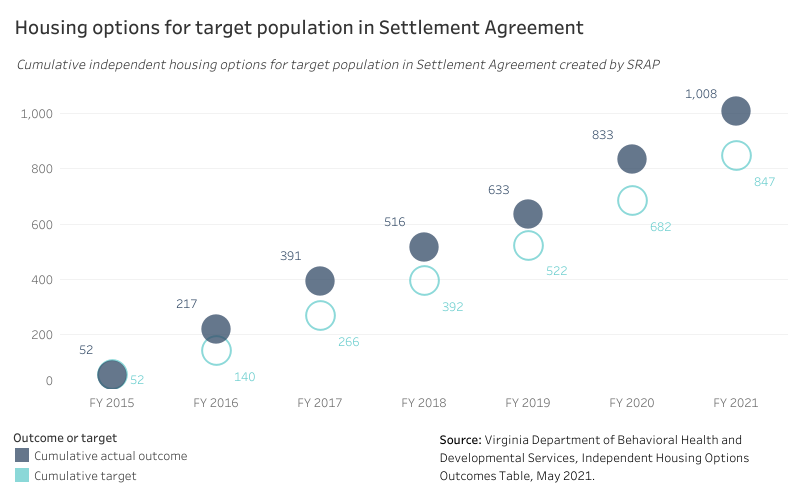State of Housing #10 • 1,036 Words
Editor’s note:
This is the tenth edition of our “State of Housing” series, which breaks down the HB854 Statewide Housing Study released this January. You can find previous posts in this series here.
A wealth of programs help improve housing opportunities for renters across the Commonwealth.
The fourth part of the HB854 Statewide Housing Study includes six chapters analyzing data on existing housing programs, including substantial feedback from housers across the Commonwealth that utilize these programs. Between Virginia Housing and the Department of Housing and Community Development, there are a multitude of programs that address housing needs in many different ways.
In this edition, we’ll focus on Virginia’s affordable rental housing production, rental assistance, and eviction prevention programs. These programs were created to assist in the development of new rental housing opportunities, as well as ensure that renters in Virginia remain stably housed. There is a lot to digest within these chapters, so we’ll focus on some key program successes and the recommendations that were developed in response to challenges and opportunities.
Each recommendation provides an explanation of why it is needed, as well as identifying those responsible for implementing it. We go further by also providing information on how the recommendations can be accomplished.
The Low-Income Housing Tax Credit Program is the most important source for affordable rental housing production in Virginia and across the U.S.
In Virginia, the tax credit pool allocated by the U.S. Department of the Treasury is administered by our state housing finance agency, Virginia Housing. Much of the feedback received from participants in focus groups and through our extensive provider survey commended Virginia Housing for their management of the LIHTC program. Virginia Housing’s transparency in the LIHTC application scoring process was often cited by developers as a major success, while Virginia Housing has also been responsive to feedback from developer and advocate calls for adjustments made to the Qualified Allocation Plan (QAP).
Preserving LIHTC affordability is just as important as creating new units.
Although the program continues to put new rental units on the ground, LIHTC properties developed by private developers are at risk of conversion to market rate after their 30-year affordability commitment. One recommendation was for Virginia Housing to conduct a comprehensive review of all active LIHTC properties to assess the potential risk of LIHTC units exiting the affordable housing supply. In addition, Virginia Housing could also explore the extension of affordability periods. Some states like California require a 55-year extended use period for 9% Tax Credit projects, while 4% Tax Credit projects frequently receive a basis boost by agreeing to the same extension period.
Why this matters: Assessing the potential loss of affordable units is important to help ensure that new units are actually contributing to a net gain. Whether through extended affordability periods or proactively identifying preservation strategies, Virginia can be confident that affordable rental housing stays affordable.
DHCD’s administration of the Virginia Rent Relief Program helped keep thousands of Virginians housed during the height of the pandemic.
Funds received through the CARES Act and the U.S. Treasury’s Emergency Rental Assistance Program were quickly deployed by DHCD through the Virginia Rent Relief Program. Launched on June 29, 2020, the program had helped over 70,000 unique low-income households by October 31, 2021. Through March 2022, RRP had increased the number of unique households served to 104,990.
While emergency rental assistance programs like RRP helped many affected by the economic pitfalls of the pandemic, tens of thousands of Housing Choice Voucher applicants were already on waitlists across the Commonwealth seeking help with rent. A survey of public housing authorities in early 2021 estimated that there were 32,000 applicants on waiting lists for a voucher. Furthermore, many stakeholders cited restrictive HCV eligibility requirements that prevent assistance from reaching those whose conditions are further exacerbated by housing instability.
Virginia Housing and DHCD aren’t the only ones with statewide rental housing programs. Other state agencies also provide rental assistance to meet specific needs.
You may not have heard that the Department of Behavioral Health and Developmental Services also has housing programs. Furthermore, it has consistently exceeded its own goals for providing rental assistance to individuals with developmental disabilities.
The State Rental Assistance Program (SRAP) is administered by DBHDS and provides rental assistance to serve individuals with developmental disabilities who are within the Settlement Agreement population. SRAP gives these individuals the opportunity to choose where they want to live, rather than be segregated from the general population, which was deemed unlawful discrimination under the Americans with Disabilities Act (ADA). Since its launch in 2015, Virginia has consistently exceeded its target in providing community-based, independent housing for persons with developmental disabilities that were covered by the Settlement Agreement.
Why this matters: As the statewide psychiatric hospital bed crisis continues, the need for safe and stable housing for those exiting care is just as critical. The study recommended that Virginia continue to scale up programs like SRAP and its Permanent Supportive Housing for Adults with Serious Mental Illness (PSH-SMI) program. These programs help prevent homelessness for individuals whose conditions can potentially become more severe with a loss of housing.
Virginia could help fill the gap left by underfunded federal housing programs.
The HB854 study called for exploring the feasibility of a state-funded rental assistance program, which also happened to be a recommendation from stakeholders who evaluated the state’s current rental programs. While rental assistance is already available through the federal Housing Choice Voucher program and for special populations, the pandemic also showed how Virginia could effectively lower eviction rates and homelessness through direct rental assistance to landlords on behalf of low-income renters.
In addition, the Joint Legislative Audit and Review Commission’s (JLARC) report on affordable housing also suggests Virginia could create a state voucher program. Efforts were underway within the General Assembly to amend the budget to pilot a state voucher program, but requests in the House and Senate did not make it into the final proposal.
Why this matters: As Federal COVID relief has ended RRP, a state-funded, non-emergency, rental assistance program could help fill the gap in assistance not provided by the federal government.
Coming up next time…
In the next edition of this series, we’ll begin exploring the HB854 study’s analysis of homeownership production and counseling, and home rehabilitation and accessibility programs.

